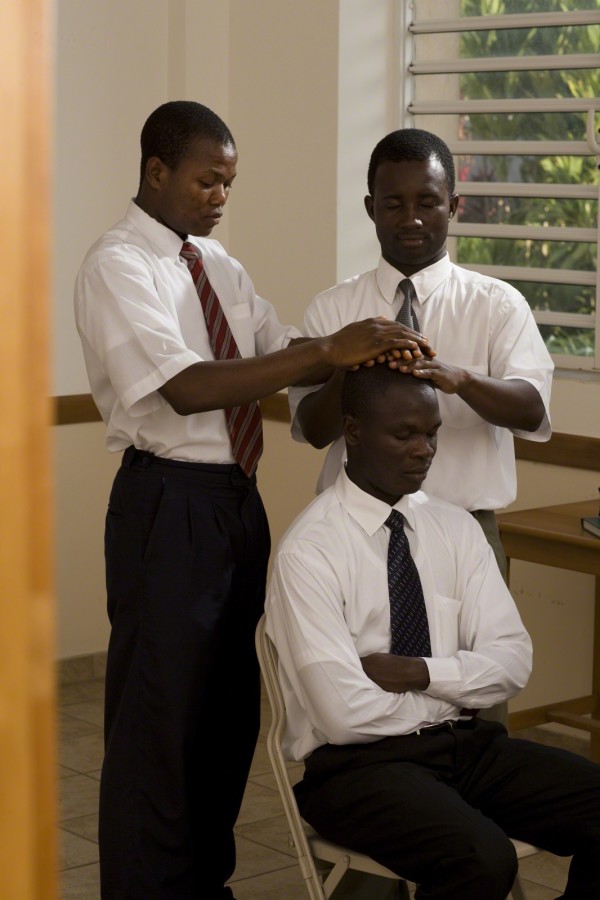What is the position of The Church of Jesus Christ of Latter-day Saints on extending the priesthood to people of every race?
 The Church was established in 1830 during an era of great racial division in the United States. At the time, many people of African descent lived in slavery and racial distinctions and prejudice were customary. Many Christian churches of that era were segregated along racial lines. However, from the beginnings of the Church, people of every race and ethnicity could become members through baptism. Church founder Joseph Smith, Jr. openly opposed slavery and allowed the ordination of a few black men, including one who participated in temple ceremonies.
The Church was established in 1830 during an era of great racial division in the United States. At the time, many people of African descent lived in slavery and racial distinctions and prejudice were customary. Many Christian churches of that era were segregated along racial lines. However, from the beginnings of the Church, people of every race and ethnicity could become members through baptism. Church founder Joseph Smith, Jr. openly opposed slavery and allowed the ordination of a few black men, including one who participated in temple ceremonies.
In 1852, Joseph Smith’s successor, President Brigham Young, publicly announced that men of black African descent could no longer be ordained to the priesthood, but that at some time in the future, black Church members would “have [all] the privilege and more” enjoyed by other members.
Over the years, Church leaders pondered the promises made by prophets such as Brigham Young that black members would one day receive priesthood and temple blessings. In June 1978, after “spending many hours in the Upper Room of the [Salt Lake] Temple supplicating the Lord for divine guidance,” Church President Spencer W. Kimball, his counselors in the First Presidency, and members of the Quorum of the Twelve Apostles received a revelation that worthy male members of any race could received the priesthood. “He has heard our prayers, and by revelation has confirmed that the long-promised day has come,” the First Presidency announced on June 8. That revelation appears in the Doctrine and Covenants as Official Declaration 2.
People have theorized about why God did not grant the priesthood to men of black African descent from the mid 1800s until 1978. One theory was that blacks descended from the lineage of Cain, who slew his brother Abel. Those who accepted this view believed that God’s “curse” on Cain was the mark of a dark skin. Another theory was that blacks were said to have been less valiant in the premortal existence.
The Church disavows these past theories that black skin is a sign of disfavor or curse or that it reflects actions in a premortal life, that mixed-race marriages are a sin, or that blacks or people of any other race or ethnicity are inferior in any way to anyone else. Church leaders unequivocally condemn all racism, past and present, in any form.
Over the past several years, Church historians have researched all existing documents to better understand the context of history and the policy that was in place from 1852 to 1978. A summary of that history is published on the page Race and the Priesthood in the Gospel Topics section of LDS.org. This is one of the pages recently enhanced in the Gospel Topics section.
The Church’s doctrine is that God loves everyone equally and makes salvation available to all. We don’t always understand God’s ways, but we acknowledge that he knows better than we do and institutes various practices at different times in history for His purposes. For example, at various times in the history of the world, God has commanded His children to practice polygamy and at other times He has not allowed it.
In the video below, President N. Eldon Tanner reads the 1978 revelation to the Church membership in general conference.
Watch videos of black members speaking about diversity, unity, and the priesthood.

As related by Pres. Tanner, this seemed like just a routine occurrence. We all know it wasn’t, of course. As a white woman growing up and living in the South, it was always heartbreaking to see the people of color who came so faithfully to church but could not reap the fullness of their faith and go to the Temple. Anyone who didn’t experience this feeling of pain for their Church family who were so denied, year after year, cannot fully understand the joy we felt at this announcement. Our joy, however, was nothing compared to that of our brothers and sisters who were finally given this wondrous gift.
Footnote 13 on the page, “Race and the Priesthood,” implies that Joseph Fielding Smith was an apostle in 1907. However, he wasn’t ordained an apostle until 1910.